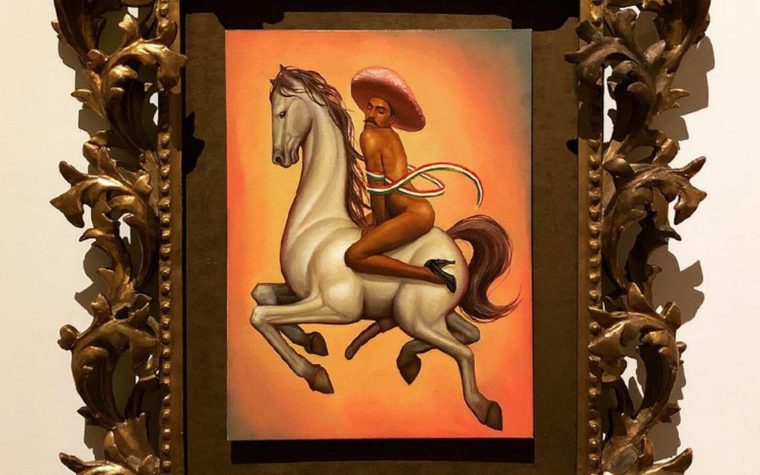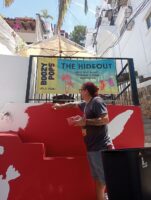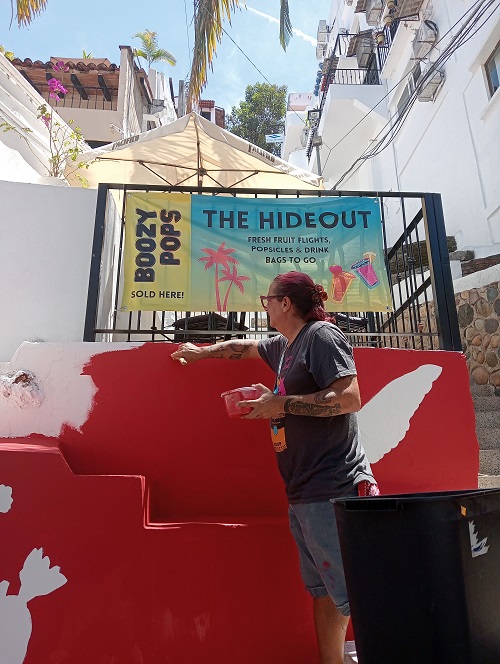EMILIANO ZAPATA, FREEDOM OF SPEECH AND GAY MEXICO RIGHTS An Opinion Article By: Victor Adrian Aguirre Roman. We at GAYPV are happy to share the personal views of one of our national readers. As you would assume, this article does not necessarily express the views of GAYPV.

A painting of Mexican revolutionary hero Emiliano Zapata, half naked, wearing high heels and a pink sombrero while riding a horse, has caused an uproar here in Mexico. The painting is in exhibition at the prestigious and world-renowned Museo del Palacio de Bellas Artes in Mexico City and has created a collision between old and new ideas, and a confrontation between Zapata, freedom of speech and gays rights.
What Does Zapata Represent to Mexicans?
To many Mexicans, including the author, Emilano Zapata is a hero. He was a leading figure in the Mexican Revolution of 1910 which was initially directed against the president, Porfirio Diaz, who many Mexicans viewed as an authoritarian dictator. Zapata formed and commanded a revolutionary force known as the Liberation Army of the South which, along with other rebel groups, forced the overthrow of “el Porfiriato,” Porifirio’s reign. All of Zapata’s followers were known as Zapatistas.
In the last six decades, Zapata’s image has been adopted by many activists, revolutionaries, and social movements here in Mexico. In the 1960’s it was adopted by the “movimiento estudiantil,” the student movement, which came to a boiling point when, on October 2, 1968, the Mexican government murdered hundreds of students who were protesting at La Plaza de Las Tres Culturas in Tlatelolco.
On January 1, 1994, an indigenous movement known as the EZLN (Ejercito Zapatista de Liberacion Nacional), the Zapatsita Army for National Liberation, vaulted onto the international consciousness when they wandered out from the lush jungles of Chiapas, fully armed, demanding respect and inclusion for indigenous cultures and ways of life.
These are the two most prominent groups who used Zapata’s image to support their battle cries and slogans. However, Zapata has also been adopted by other social movements in recent times, most notably by the feminist movement, and now, by the gay rights movement. It is the gay rights movement which has caused the biggest stir with the painting of Zapata mentioned above.
The Importance of Freedom of Speech and Expression
Article 6 of the Mexican Constitution states that “[T]he expression of ideas shall not be subject to any judicial or administrative investigation, unless it offends good morals, infringes the rights of others, incites to crime, or disturbs the public order.”
Freedom of speech and expression is a fundamental human right and important for a healthy society. Freedom of speech, throughout history, has been instrumental in fighting for change and justice. The rights many of us have today would not have been obtained were it not for freedom of speech and expression. Women would continue to be disenfranchised, slaves would continue in bondage, and people would have continued to work in deplorable, inhumane conditions if someone had not been able to express their opposition and/or revulsion at these injustices which ultimately led to their demise. So, free speech is not just something good to have, it is essential to the prosperity and wellbeing of any developing society.
Zapata and Gay Rights
I have to admit that when I first saw Zapata’s “gay” painting, I was shocked and a bit angered. I wasn’t shocked because I am anti-gay or homophobic, I am not. I was shocked because Zapata is a hero to me. I have a tattoo of him, standing tall in his charro outfit, a Mexican flag-colored ribbon draped around his shoulder and torso, holding a rifle, proudly and defyingly staring at the camera. It is an iconic photograph of a man who, to me,
represents fighting against injustice. Seeing him in high heels and a pink sombrero shocked me.
But freedom of speech demands that we respect other’s ideas, beliefs and expressions no matter how uncomfortable they make us feel. As the English author Evelyn Beatrice Hall wrote, “I may disapprove of what you say, but I will defend your right to say it.”
This polemic painting at Palacio de Bellas Artes is part of an exhibition entitled “Otras Revoluciones,” other revolutions. Fabian Chairez, the painter, wanted to convey the message that gays are currently oppressed in our “machista” Mexican society and are fighting a revolution to have rights and justice, just like the indigenous and student movements which used Zapata’s image to promote their grievances.
This we should wholeheartedly support. Gays deserve the rights they demand – the right to be treated equally regardless of sexual orientation. Here in Mexico, our “macho” society treats women and homosexuals as second-class citizens. On paper, it looks as if gay rights are honored. Mexico abolished most discriminatory legal distinctions based on sexual orientation long before the United States and other “First World” countries. Mexico decriminalized sodomy in 1871, more than 100 years before the U.S. did in 2003.
But the extremely angry reaction to this Zapata painting from certain groups – from “campesinos” raiding Palacio de Bellas Artes to demand the painting be taken down “or else”, or Zapata’s family threatening to use any measures necessary to stop the exhibition – shows that we are far from truly having the just society we claim to have on paper.
This needs to change. Malcom X, when talking about segregation of black Americans, said: “You get your freedom by not being confined. You get your freedom by letting your enemy know that you’ll do anything to get your freedom. You’ll get it. It’s the only way you will get it.” With this painting, Chairez did not confine himself to “politically correct” speech. The shocking response to it exposed the truth about where we are as a society.
In places where freedom of speech is allowed and protected, there is almost a guarantee that someone will be “offended” and “shocked” by the expression of ideas different than their own. I was shocked with this painting, but it was this shock that made me reflect on the idea of freedom of speech and to rethink my position. This painting has made gay rights the talk of national news and conversation. That is a good thing. All change begins with dialogue and debate – the sharing of different ideas on what a just society should look like. We may not agree with a “gay” Zapata painting. In fact, we may be offended by it. But we should fully support the right of Chairez and Palacio Nacional de Bellas Artes to express their views and adopt Zapata for the gay rights cause. It makes our society a truly democratic one in which we all get to have the freedom to speak and express ourselves
without repression from others. Viva Zapata!
About the Author of this Editorial Opinion Article
Victor Adrian Aguirre Roman is the director of the Volcanes Kids Education Project, a program working to end poverty through education. He is the author of Last of the Human Freedoms: Choosing the Road to Redemption. To learn more about the Volcanes Kids Education Project, visit their website at ww.volcanesproject.com. You can also contact Victor at va390289@gmail.com.










